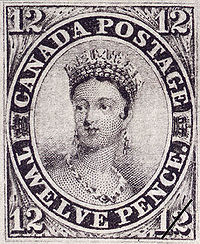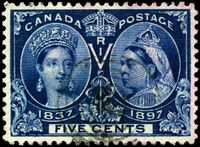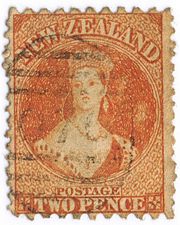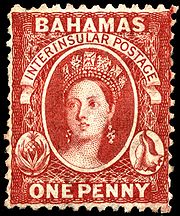
Chalon head
Encyclopedia

Postage stamp
A postage stamp is a small piece of paper that is purchased and displayed on an item of mail as evidence of payment of postage. Typically, stamps are made from special paper, with a national designation and denomination on the face, and a gum adhesive on the reverse side...
series whose illustration was inspired by a portrait of Queen Victoria
Victoria of the United Kingdom
Victoria was the monarch of the United Kingdom of Great Britain and Ireland from 20 June 1837 until her death. From 1 May 1876, she used the additional title of Empress of India....
by Alfred Edward Chalon
Alfred Edward Chalon
Alfred Edward Chalon was a Swiss portrait painter. He lived in London where he was noticed by Queen Victoria.- Biography :...
(1780–1860).
These stamps, printed in New York City
New York City
New York is the most populous city in the United States and the center of the New York Metropolitan Area, one of the most populous metropolitan areas in the world. New York exerts a significant impact upon global commerce, finance, media, art, fashion, research, technology, education, and...
for the Canadian colonies, and by Perkins, Bacon and Company
Perkins Bacon
Messrs. Perkins, Bacon & Co was a printer of books, bank notes and postage stamps, most notable for printing the Penny Black, the world's first adhesive postage stamps, in 1840.- Origins :...
in London
London
London is the capital city of :England and the :United Kingdom, the largest metropolitan area in the United Kingdom, and the largest urban zone in the European Union by most measures. Located on the River Thames, London has been a major settlement for two millennia, its history going back to its...
, were issued in many British colonies from the 1850s until 1912 in Queensland. In chronological order, they were released in the Province of Canada
Province of Canada
The Province of Canada, United Province of Canada, or the United Canadas was a British colony in North America from 1841 to 1867. Its formation reflected recommendations made by John Lambton, 1st Earl of Durham in the Report on the Affairs of British North America following the Rebellions of...
in 1851, Nova Scotia
Nova Scotia
Nova Scotia is one of Canada's three Maritime provinces and is the most populous province in Atlantic Canada. The name of the province is Latin for "New Scotland," but "Nova Scotia" is the recognized, English-language name of the province. The provincial capital is Halifax. Nova Scotia is the...
in 1853, Tasmania
Tasmania
Tasmania is an Australian island and state. It is south of the continent, separated by Bass Strait. The state includes the island of Tasmania—the 26th largest island in the world—and the surrounding islands. The state has a population of 507,626 , of whom almost half reside in the greater Hobart...
and New Zealand
New Zealand
New Zealand is an island country in the south-western Pacific Ocean comprising two main landmasses and numerous smaller islands. The country is situated some east of Australia across the Tasman Sea, and roughly south of the Pacific island nations of New Caledonia, Fiji, and Tonga...
in 1855, The Bahamas
The Bahamas
The Bahamas , officially the Commonwealth of the Bahamas, is a nation consisting of 29 islands, 661 cays, and 2,387 islets . It is located in the Atlantic Ocean north of Cuba and Hispaniola , northwest of the Turks and Caicos Islands, and southeast of the United States...
and Natal
Colony of Natal
The Colony of Natal was a British colony in south-eastern Africa. It was proclaimed a British colony on May 4, 1843 after the British government had annexed the Boer Republic of Natalia, and on 31 May 1910 combined with three other colonies to form the Union of South Africa, as one of its...
in 1859, Grenada
Grenada
Grenada is an island country and Commonwealth Realm consisting of the island of Grenada and six smaller islands at the southern end of the Grenadines in the southeastern Caribbean Sea...
, New Brunswick
New Brunswick
New Brunswick is one of Canada's three Maritime provinces and is the only province in the federation that is constitutionally bilingual . The provincial capital is Fredericton and Saint John is the most populous city. Greater Moncton is the largest Census Metropolitan Area...
and Queensland
Queensland
Queensland is a state of Australia, occupying the north-eastern section of the mainland continent. It is bordered by the Northern Territory, South Australia and New South Wales to the west, south-west and south respectively. To the east, Queensland is bordered by the Coral Sea and Pacific Ocean...
in 1860, and in 1870 in Prince Edward Island
Prince Edward Island
Prince Edward Island is a Canadian province consisting of an island of the same name, as well as other islands. The maritime province is the smallest in the nation in both land area and population...
.
Because these are some of the world's first stamps or the very first stamps to bear these colonies' names, the Chalon series are objects of many studies and collections.
Original portrait

House of Lords
The House of Lords is the upper house of the Parliament of the United Kingdom. Like the House of Commons, it meets in the Palace of Westminster....
where she prorogated the Parliament of the United Kingdom
Parliament of the United Kingdom
The Parliament of the United Kingdom of Great Britain and Northern Ireland is the supreme legislative body in the United Kingdom, British Crown dependencies and British overseas territories, located in London...
in July 1837. Chalon's work was intended as a gift from Victoria to her mother
Princess Victoria of Saxe-Coburg-Saalfeld
Princess Victoria of Saxe-Coburg-Saalfeld was the mother of Queen Victoria of the United Kingdom.-Early life:...
.
In the portrait she is wearing the George IV State Diadem
George IV State Diadem
Part of the British Crown Jewels, the George IV State Diadem or Diamond Diadem was made in 1820 by the firm Rundell, Bridge and Rundell for the coronation of King George IV. It was designed to encircle the King's velvet Cap of Estate that he wore in the procession to Westminster Abbey. The diadem...
, created in 1820, and the State Robes, a dress and a long royal mantle. Her body is half-turned to the right side, on top of a flight of stairs. While her head is turned to the right, her left hand holds the plinth of a column on which there is a sculpted lion.
At that time, this portrait was also known as the "Coronation portrait" because an engraving by Samuel Cousins
Samuel Cousins
Samuel Cousins was an English mezzotint engraver, born at Exeter.He was preeminently the interpreter of Sir Thomas Lawrence, his contemporary. During his apprenticeship to S. W. Reynolds he engraved many of the best amongst the three hundred and sixty little mezzotints illustrating the works of...
was distributed to the public on June 28, 1838.
On the stamps
On the stamps, which are mainly of a small size, the effigy is reproduced inside an ovalOval
An oval is any curve resembling an egg or an ellipse, such as a Cassini oval. The term does not have a precise mathematical definition except in one area oval , but it may also refer to:* A sporting arena of oval shape** a cricket field...
that has two main forms; the oval is either large enough to see the Queen's necklace, or too small so that only the upper part of the neck is visible, but excludes the necklace.
On the New Zealand stamps the circle has a larger diameter so that the upper part of the State Robes are also visible.
The engravings for many of these stamps were produced by William Humphrys
William Humphrys
William Humphrys was an engraver of pictures, book illustrations and postage stamps.Humphrys was born in Dublin. At an early age he moved to the United States where he studied engraving techniques under George Murray in Philadelphia...
.
Canada

Ontario
Ontario is a province of Canada, located in east-central Canada. It is Canada's most populous province and second largest in total area. It is home to the nation's most populous city, Toronto, and the nation's capital, Ottawa....
and Quebec
Quebec
Quebec or is a province in east-central Canada. It is the only Canadian province with a predominantly French-speaking population and the only one whose sole official language is French at the provincial level....
) was the first colony to use the Chalon head on its first stamps. The April 9, 1851, two of the six first stamps bore this portrait: the 7 and a half pence green and the 12 pence black. After the adoption of the Canadian dollar
Canadian dollar
The Canadian dollar is the currency of Canada. As of 2007, the Canadian dollar is the 7th most traded currency in the world. It is abbreviated with the dollar sign $, or C$ to distinguish it from other dollar-denominated currencies...
, one additional stamp was issued in July 1859 with the Chalon head, the 12 and a half cents (with its former denomination of "SIX PENCE STERLING"). Like the previous series, these stamps were printed in New York.
Three other colonies knew Chalon head stamps before their integration to the Confederation of Canada: Nova Scotia in May 1860 (one stamp with the effigy inside a large square stamp put on its point, printed by Perkins, Bacon & Co, New Brunswick in May 1860 (three stamps printed in New York) and Prince Edward Island in June 1870 (one denomination). The last one is the only one printed in Canada, by the British-American Banknote Company.
For the Diamond Jubilee of Queen Victoria in 1897, the Confederation issued a commemorative stamp
Commemorative stamp
A commemorative stamp is a postage stamp, often issued on a significant date such as an anniversary, to honor or commemorate a place, event or person. The subject of the commemorative stamp is usually spelled out in print, unlike definitive stamps which normally depict the subject along with the...
that employed the Chalon head and more recent portrait by Heinrich von Angeli.
New Zealand

If the 1 penny and 2 pence of 1855 were printed in London by Perkins, Bacon & Co, their successors were locally printed as soon as 1856 by J. Richardson in Auckland
Auckland
The Auckland metropolitan area , in the North Island of New Zealand, is the largest and most populous urban area in the country with residents, percent of the country's population. Auckland also has the largest Polynesian population of any city in the world...
and by John Davis in 1862.
Separations
Postage stamp separation
For postage stamps, separation is the means by which individual stamps are made easily detachable from each other.Methods of separation include:# perforation: cutting rows and columns of small holes...
appeared at the end of the 1850s, but didn't concern all stamps and appear in many forms of perforation
Perforation
A perforation is a small hole in a thin material or web. There is usually more than one perforation in an organized fashion, where all of the holes are called a perforation...
(points, lines or holes). In 1864, a scarcity of paper with six-pointed star watermark
Watermark
A watermark is a recognizable image or pattern in paper that appears as various shades of lightness/darkness when viewed by transmitted light , caused by thickness or density variations in the paper...
obliged to use paper with "NZ" watermark.
Tasmania
Van Diemen's LandVan Diemen's Land
Van Diemen's Land was the original name used by most Europeans for the island of Tasmania, now part of Australia. The Dutch explorer Abel Tasman was the first European to land on the shores of Tasmania...
used the Chalon portrait on its second issue of 1855 and again under its new name Tasmania from 1858 to 1870. The design around the portrait is uncommon compared to other Chalon series.
Bahamas

Pineapple
Pineapple is the common name for a tropical plant and its edible fruit, which is actually a multiple fruit consisting of coalesced berries. It was given the name pineapple due to its resemblance to a pine cone. The pineapple is by far the most economically important plant in the Bromeliaceae...
and conch
Conch
A conch is a common name which is applied to a number of different species of medium-sized to large sea snails or their shells, generally those which are large and have a high spire and a siphonal canal....
but, Perkins, Bacon & Co judged that such a stamp design would be too difficult to print and to perforate.
The printing company proposed a project derived from others Chalon issues: the oval of the portrait should be reduced in size and two little ovals appeared for the two Bahamian products. A banderole precised the use of the one penny stamp: "INTERINSULAR POSTAGE".
The first package of stamps printed in London were put on sale in the Bahamas the June 10, 1859. Perforations appeared in September 1860 but they were perfectly mastered by Perkins Bacon after 1863 (14 holes for 2 cm).
To replace British stamps on the mail sent to North America and the United Kingdom, two new values are issued; 4 pence rose and 6 pence grey. The pineapple and conch ovals were no longer used.
Queensland
When Queensland separated from New South WalesNew South Wales
New South Wales is a state of :Australia, located in the east of the country. It is bordered by Queensland, Victoria and South Australia to the north, south and west respectively. To the east, the state is bordered by the Tasman Sea, which forms part of the Pacific Ocean. New South Wales...
they issued the first stamps with a Chalon effigy in 1860 and replaced them in 1880. The Chalon head reappeared in 1882 on bigger stamps printed in intaglio
Intaglio (printmaking)
Intaglio is a family of printmaking techniques in which the image is incised into a surface, known as the matrix or plate, and the incised line or area holds the ink. Normally, copper or zinc plates are used as a surface, and the incisions are created by etching, engraving, drypoint, aquatint or...
or lithography
Lithography
Lithography is a method for printing using a stone or a metal plate with a completely smooth surface...
, on high value stamps denominated from 2 shillings to one pound. This series was available until 1912 with the arrival of the Commonwealth of Australia
Australia
Australia , officially the Commonwealth of Australia, is a country in the Southern Hemisphere comprising the mainland of the Australian continent, the island of Tasmania, and numerous smaller islands in the Indian and Pacific Oceans. It is the world's sixth-largest country by total area...
stamps.
Natal

Grenada
Grenada's first postage stamps used one of the main Chalon design with the name and denomination horizontally printed relative on the top and bottom of the stamp.On the 1859 series the necklace was visible, but on the 1875 series the effigy was placed inside a small circle that masked the Queen's neck. A new design was issued in 1883.
Collection and studies
Because the stamps with the effigy inspired by Chalon's portrait are the first or one of the first stamps of these colonies, their study is well-developed by classical philatelists and 19th century postal historians.Concerning the Bahamian Chalons, Louis E Bradbury, treasurer of the Royal Philatelic Society London (RPSL) between 1927 and 1945, accumulated stamps, documents and correspondence between British governmental services and Perkins Bacon. After his death on 7 July 1950, his collection was received by the RPSL.
In fine and unused condition, these series are among the most priced stamps of British colonial philately. For example, in February 2006, at the auctions of Gawaine Baillie
Sir Gawaine Baillie, 7th Baronet
Sir Gawaine Baillie, 7th Bt was an amateur motor racing driver, engineer, industrialist, stamp collector, and the owner of the ancient estate surrounding Leeds Castle, the ancient fortress in Kent...
's collection, a Province of Canada 12 pence black was sold £116,000 sterling pounds and a New Zealand Chalon printed in London reached £69,000 pounds. They were the highest prices paid for single stamps from British colonies during these auctions.
External links
- Ann Mette Heindorff, « The First Art Stamp Ever? », article published on the Art History on Stamps website, updated 24 July 2006, page viewed 11 August 2007. Chalon head may be the first stamps inspired by a painting.
- Canadian stamps (1851-1875) on the site of Library and Archives CanadaLibrary and Archives CanadaLibrary and Archives Canada is a national memory institution dedicated to providing the best possible account of Canadian life through acquiring, preserving and making Canada's documentary heritage accessible for use in the 21st century and beyond...
. - G. Law, New Zealand Chalon Portrait, page viewed 9 August 2007.

